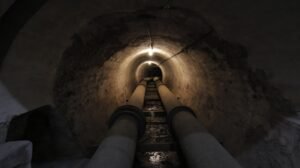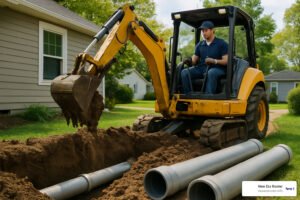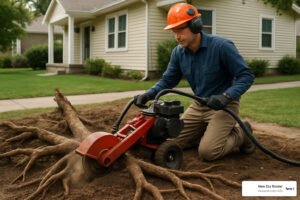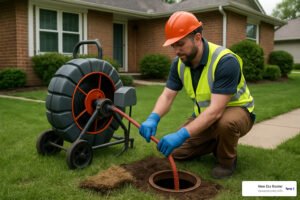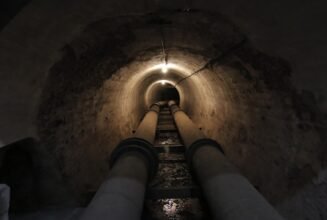Why Sewer Line Maintenance is Your Home’s Silent Guardian
Sewer line maintenance is the regular care and inspection of your home’s underground pipes that carry wastewater away from your property. Here’s what every homeowner needs to know:
Essential Maintenance Tasks:
- Schedule professional inspections every 18-24 months
- Avoid flushing grease, wipes, and non-biodegradable items
- Use enzyme cleaners monthly to break down organic buildup
- Install root barriers near trees to prevent pipe intrusion
- Watch for warning signs like slow drains, odors, or lush lawn spots
Most homeowners remember to clean gutters and winterize pipes, but one commonly forgotten task is cleaning the main sewer line to avoid nasty water damage and costly repairs. Your sewer system works 24/7, silently moving waste away from your home through a network of underground pipes that can last 25-100 years depending on their material.
But here’s the reality check: fixing a damaged sewer pipe can cost up to $300 per foot, while complete sewer drain replacement ranges from $2,500 to over $30,000. Meanwhile, basic maintenance like snaking costs just $100-$250, and professional camera inspections run $100-$500.
The math is simple – preventative care saves thousands. Regular maintenance catches problems before tree roots crack your clay pipes, before grease hardens into concrete-like blockages, and before minor leaks turn into yard-flooding disasters that damage your foundation.

Sewer line maintenance vocab explained:
The Ultimate Sewer Line Maintenance Game Plan
Think of your sewer line as your home’s unsung hero – working around the clock to keep everything flowing smoothly. When it’s healthy, you don’t even think about it. But when problems strike, you’re suddenly facing backups, awful smells, and repair bills that can reach into the tens of thousands.
The good news? Most sewer disasters are completely preventable with the right approach. Let’s explore a game plan that’ll keep your system running like clockwork for decades to come.

Know Your Pipes: Types & Common Threats
Here’s something most homeowners don’t realize: sewer line maintenance strategies depend entirely on what’s buried under your yard. After years of working with pipes across Lake Elsinore and surrounding areas, we’ve learned that each material has its own personality and quirks.
Clay pipes were the go-to choice for homes built before 1950, and they’re still chugging along in many neighborhoods. The challenge? These pipes have joints every three feet, and tree roots seem to have a sixth sense for finding them. Once roots find that steady source of moisture and nutrients, they’ll create blockages that can shut down your entire system.
If your home was built between 1950 and 1960, you might have Orangeburg pipes – made from compressed wood fibers and tar. These rarely have root problems, but they can collapse or develop “pipe bellies” where waste gets trapped. Think of it like a sock that’s lost its elastic.
Cast iron pipes became popular in the late 1960s and are still common today. They’re tough, but they develop internal rust buildup over time. This rough, scaly interior acts like velcro for debris, turning minor clogs into major headaches.
PVC pipes are the modern gold standard. They can last over 100 years and resist root intrusion beautifully. But even these champions need regular cleaning to prevent FOG buildup – that’s fats, oils, and grease that can harden into concrete-like blockages.
Sewer Line Maintenance Red Flags to Catch Early
After responding to thousands of emergency calls, we’ve noticed that certain warning signs always appear before major problems. Catching these early can save you serious money and stress.
Multiple drains acting up at once is your biggest red flag. When your toilet, sink, and shower all start draining slowly simultaneously, that’s not bad luck – that’s your main sewer line telling you it needs help.
That unmistakable sulfur smell isn’t just unpleasant; it’s hydrogen sulfide gas escaping from your system. This rotten egg odor often means you have a backup or break somewhere in your line.
Unusually green patches in your lawn might look nice, but they’re actually warning signs. Underground sewage leaks act like fertilizer, creating these lush spots before you notice any indoor symptoms.
Gurgling sounds from your fixtures mean air is trapped in your system. When your toilet makes noise after you run the bathroom sink, or your shower starts bubbling, you likely have a partial blockage downstream.
Sudden pest problems can also signal sewer issues. Insects and rodents are drawn to the moisture and organic matter from leaks, so an uptick in unwanted visitors might mean it’s time for an inspection.
DIY Hacks: From Baking Soda Blasts to Monthly Power Flush
You don’t need to be a plumber to keep your sewer system happy. These simple techniques can prevent most common problems and extend the life of your pipes.
The monthly baking soda treatment is like a spa day for your drains. Mix half a cup of baking soda with half a cup of white vinegar, pour it down each drain, wait 15 minutes, then flush with hot water. This natural combination breaks down grease and organic buildup without harsh chemicals that can damage older pipes.
Our simultaneous flush technique creates a powerful cleaning surge once a month. Fill all your sinks, tubs, and washing machine with cold water, then drain them all at once while flushing every toilet. This surge pushes debris through low spots and pipe bellies where waste typically gets stuck.
Switching to one-ply toilet paper might not sound glamorous, but it dissolves much faster and reduces clog risk, especially in systems with root intrusion or pipe sags.
The grease jar method is simple but effective – keep a coffee can by your stove and scrape cooking fats into it instead of down the drain. Once it solidifies, toss it in the trash. This prevents the number one cause of kitchen drain blockages.
Your toilet isn’t a trash can, and certain items should never go down there: wet wipes (even “flushable” ones), feminine hygiene products, dental floss, cat litter, medications, paper towels, cotton swabs, or hair from brushes.
Root barriers are worth considering if you have trees within 100 feet of your sewer line. These underground plastic or metal sheets redirect root growth away from your pipes and can prevent thousands in future damage.
Seasonal Sewer Line Maintenance Checklist
Living in Southern California means dealing with unique seasonal challenges that can stress your sewer system in different ways throughout the year.
Spring preparation is all about getting ready for storm season. Test your backwater valve to make sure it’ll prevent sewage backup during heavy rains. Clear any debris from your sewer cleanout access point, and this is the perfect time to schedule your annual camera inspection to catch any winter damage.
Summer drought management requires special attention because our hot, dry weather causes soil to shift and crack. This movement can damage pipes and create new entry points for roots. Water your lawn moderately to prevent extreme soil movement, watch for new cracks in your foundation or driveway, and increase enzyme treatments to monthly during peak heat.
Autumn maintenance focuses on debris control. Keep storm drains clear of leaves, trim tree branches hanging over your roof, and consider professional root cutting if you’ve had issues before.
Winter freeze protection might seem unnecessary in our mild climate, but cold snaps still happen. Insulate any exposed pipes in crawl spaces or garages, know where your main water shutoff is located, and keep a trickle of water running during freezing nights.

The key to successful sewer line maintenance is consistency. These simple steps, done regularly, can prevent 90% of the emergency calls we receive. Your future self (and your wallet) will thank you for taking action now instead of waiting for problems to find you.
Calling in the Pros & Protecting Your Wallet
Sometimes your trusty plunger and DIY tricks just aren’t enough. When that moment comes, knowing what to expect from professional service and how to protect your wallet can save you thousands. Let’s walk through the smart homeowner’s guide to professional sewer line maintenance.

What to Expect During a Professional Sewer Line Maintenance Inspection
Think of a professional sewer inspection like a thorough physical exam for your home’s plumbing. You wouldn’t skip your annual checkup, and your sewer system deserves the same attention.
The camera crawl is where the magic happens. We thread a high-resolution camera through your sewer cleanout, giving you a front-row seat to what’s really happening down there. It’s actually pretty fascinating – you’ll see exactly where tree roots are sneaking in, spot any cracks or breaks, and identify buildups before they become major headaches.
The flow test comes next. We measure how quickly water moves through your system to catch restrictions or low spots where waste might be pooling. These “pipe bellies” are sneaky troublemakers that can cause repeated backups if left untreated.
When we find roots (and we often do), mechanical cutting takes care of business. Our cutting heads slice through roots right back to the pipe wall, removing all the debris. It’s not just pushing the problem down the line – we’re actually solving it.
For stubborn grease buildup or scale deposits, hydro jetting brings out the big guns. High-pressure water at up to 4,000 PSI scours your pipes cleaner than the day they were installed. Cast iron pipes especially benefit from this treatment, as it removes all that rust buildup that catches debris.
Follow-up documentation might sound boring, but it’s your insurance policy. We re-scope the line after cleaning to prove the work was done right, and you get a detailed report with before-and-after videos. Keep these records – they’re gold when it comes to warranty claims or selling your home.
Most homes benefit from camera inspections every 2-3 years, with annual checks if you’ve had problems before. Professional cleaning typically happens every 18-24 months, though homes with nearby trees might need root cutting annually.
For more detailed information about what to expect during a sewer scope inspection, check out this comprehensive sewer scope inspection guide that covers the entire process.
Smart Spending: Insurance, Warranties & Next-Gen Tech
Here’s where smart homeowners separate themselves from the crowd. Most homeowner’s insurance policies don’t cover sewer line problems – a harsh reality many find too late. But you can add a sewer backup rider for just $50-100 annually that covers up to $10,000 in damage.
When you consider that the average sewer backup causes $3,000-7,000 in damage, this coverage is a no-brainer. We’ve seen too many families face devastating cleanup costs that could have been avoided with this simple addition.
Warranty compliance is another often-overlooked detail. If your home is newer, maintaining professional service records might be required to keep your plumbing warranty valid. Those service receipts aren’t just clutter – they’re protecting your investment.
The plumbing world is embracing some exciting next-generation technology. Cured-in-place pipe lining installs a brand-new pipe inside your old one using epoxy-soaked fabric that hardens in place. No digging, no yard destruction, and it can extend your system’s life by 50+ years. The upfront cost is higher, but the long-term value is incredible.
Smart monitoring systems with IoT sensors are starting to appear in residential settings. These clever devices monitor flow rates, detect blockages, and can even predict failures before they happen. While still emerging, they’re becoming more affordable and could revolutionize home maintenance.
Let’s talk real numbers for a minute. Annual preventive maintenance runs $200-400. Compare that to an emergency weekend service call at $500-1,000, major line repairs at $3,000-15,000, or complete replacement at $10,000-30,000. The math is pretty clear.
At New Era Rooter, we’ve helped thousands of families across Lake Elsinore, Temecula, San Diego, and surrounding areas avoid these costly disasters. Our 24/7 emergency service means you’re never alone when problems strike, and our skilled professionals use state-of-the-art equipment to deliver results that last.
We understand Southern California’s unique challenges – the soil conditions, climate effects, and aging infrastructure that make our region special. Whether it’s high-pressure jetting systems, advanced camera equipment, or trenchless repair technologies, we bring the right tools for your specific situation.
Call us immediately if you notice multiple fixtures backing up, sewage odors in your home or yard, water backing up into floor drains, gurgling sounds from multiple fixtures, or wet spots in your yard. Don’t wait for a weekend emergency when rates are higher and your stress levels are through the roof.
Sewer line maintenance isn’t just about preventing problems – it’s about protecting your family’s health, your property’s value, and your peace of mind. For more information about our comprehensive sewer line services, contact our team of experts who are available around the clock to keep your home’s most important system flowing smoothly.
A well-maintained sewer system is an invisible blessing. You never think about it when it’s working properly, but when it fails, it becomes your biggest nightmare. With regular professional care and smart financial planning, you can keep that nightmare from ever becoming reality.



